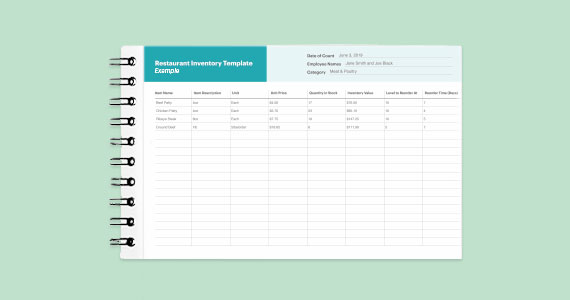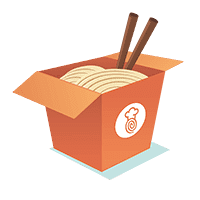As a restaurateur, your success relies on sourcing quality ingredients at sustainable prices. Inventory costing methods can help keep your expenses in check. After all, you want to be able to keep creating recipes that your customers love, without breaking the bank.
Yet the average restaurant spends between 20-40% of its expenses on food – that takes up a large portion of cash! This is also a reason why you should consider following restaurant inventory best practices.
With an effective inventory costing method, you will be able to ensure you can keep up with your spending habits and save money for so many other important operational expenses – like labor, rent, utilities, marketing, and advertising.
To help you get started, we’ve broken down inventory costing methods into easy to understand concepts with real-life examples, covering topics such as:
- What is Inventory Costing?
- Inventory Costing Methods
- First In, First Out (FIFO)
- Last In, First Out (LIFO)
- Weighted Average Cost (WAC)
Ready to stay on top of costs when purchasing and selling new products? Let’s get started.

Simplify your inventory counts with our free restaurant inventory template.
What Is Inventory Costing?
Inventory costing is when companies assign a cost to products. These hidden costs can include fees such as storage, administrative costs, or market fluctuation. For a restaurant, these costs may include the cost of kitchen or storage space, the cost of money such as debt or interest, or the cost of waste, such as spoiled and damaged foods.
Cost is a major part of restaurant inventory management. It can help restaurant owners stay on top of their expenses and assist in determining how much of a product they should carry. This helps ultimately restaurateurs decide on margins – the revenue they will make after paying the cost of goods sold (COGS).
How Inventory Differs from COGS
There are many reasons why a restaurant could experience low levels of profit, but the cost of food is often a major factor. That’s why it’s important to understand the concepts of inventory (purchases) and the costs of goods sold – they are actually very different!
Let’s take a closer look.
What Is Inventory?
Inventory is your products – the food and drinks that have been bought but not yet sold to customers. For restaurants, this could be fresh meat, frozen food, fresh produce, beer or liquor bottles, soda cans, or any product that can be bought and resold to customers. They can be sold on their own, or mixed with other ingredients to complete a dish.
What is the Cost of Goods Sold?
The Cost of Goods Sold (COGS) is the cost of the products that were already sold to customers. This includes the cost of what goes on a plate, or in a mixed alcohol drink that is being served. COGS is usually calculated over a week or monthly time period.
Since the profitability of your restaurant is calculated using the cost of goods sold, it is also important that the value of your inventory is as accurate as possible. So how do you determine the cost? To do this, you’ll need to know how much each product is worth.
Inventory Costing Methods
Thankfully, there are a few options to help restaurateurs determine the cost of goods sold, and we’ve outlined each of them below:
- FIFO (first in, first out)
- LIFO (last in, first out)
- WAC (weighted average cost)

First In, First Out (FIFO)
What is FIFO?
First In, First Out refers to the valuation method of selling the oldest inventory you own first. As a result, the value of your remaining inventory will be based on the most recent inventory you purchased.
This method is most popular among restaurant owners because it reflects how the industry works in real life. For example, a coffee shop would use its older beans first to keep its remaining stock fresh.
How to Calculate FIFO
To calculate your Cost of Goods Sold (COGS) using the FIFO inventory method, you’ll need to figure out the cost of your oldest inventory. Then, multiply that cost by the amount of inventory sold.
For example, let’s say Bob’s Bistro buys and resells bottles of wine. Here is what it’s been costing Bob to build up his bar inventory since his restaurant opened:
| Month | Amount | Price Paid |
| January | 100 bottles | $20.00 per |
| February | 100 bottles | $45.00 per |
| March | 100 bottles | $80.00 per |
Let’s say Bob wants to calculate the cost of goods sold in the first quarter of the year at the beginning of April. Bob has sold 90 bottles so far.
The COGS formula is:
(Amount of Units Sold) x (Price Paid Per Unit) = Cost of Goods Sold
90 x $20.00 = $1,800
Since Bob is using the FIFO inventory costing method, he will use the oldest cost of $20.00 per bottle in his calculation.
Using the FIFO Inventory Method
With the FIFO inventory method, purchases at the end of a sales period have no effect on the cost of goods sold or net revenue. This leads to several pros and cons:
Pros of FIFO
- Easy to apply right away.
- Decreases waste and keeps food and beverages fresh.
- Great for items that have a short demand cycle or which are perishable.
- Matches the actual flow of food in the kitchen, as goods with the nearest expiration date are consumed first to avoid spoiling.
- Advantageous in an inflationary period when costs continue to rise since lower-priced goods are used first and more expensive items are kept as inventory.
- A lower cost of goods sold leads to a higher net income.
Cons of FIFO
- Yields higher income taxation during periods of inflation.
- Costs and revenue are mismatched because older and lower costs are matched with the current revenue which can lead to misleading profit predictions.

Simplify your inventory counts with our free restaurant inventory template.
Last In, First Out (LIFO)
What is LIFO?
Last-In, First Out refers to the valuation method of selling the newest purchases added to your inventory first. As a result, the value of your remaining stock will be based on the oldest products you purchased.
The LIFO inventory method is especially useful when inventory costs are on the rise, like during inflation. This also means the cost of sale will be higher when more expensive items are sold first. In addition, less taxes will be paid if profit is lower, which can lead to significant savings overtime.
Since most restaurants are looking to sell their oldest stock first, the LIFO method is not usually the preferred choice. But, in some circumstances, it can be used to make your restaurant look more profitable. For example, it could be used in a presentation to show how your business runs. It’s also important to note that this method is only legal in the United States.
How to Calculate LIFO
In order to calculate your COGS (cost of goods sold) with the LIFO inventory method, you’ll need to determine the cost of your newest inventory. Then multiply this amount by the total amount of inventory sold.
It looks like Bob didn’t choose the best time to start selling bottles of wine. After all, the cost of his inventory started increasing month over month, as shown in the ‘Price Paid’ column for February and March. Instead, Bob now chooses to use the LIFO method, so he will use the price it cost him to buy bottles in March.
Bob’s calculation for COGS is as follow:
(Amount of Units Sold) x (Price Paid Per Unit) = Cost of Goods Sold
90 x $80.00 = $7,200
Since Bob is using the LIFO method, he uses the most recent cost of $80 per bottle in his calculation. Since his costs of goods sold are high, he will get a lower tax rate. The 210 bottles that haven’t been sold will count as inventory.
Using the LIFO Inventory Method
With LIFO, inventory purchases at the beginning of a sales period have no effect on the cost of goods sold, or net revenue. This leads to several pros and cons:
Pros of LIFO
- Lower tax rates because recent inventory is purchased at a higher price, resulting in a larger deduction.
- Provides a closer estimate of current earnings by matching most recent costs against most current revenues.
- This method is advantageous for stacking and storing non-perishable food in the order it comes. Newer products are more accessible to staff, saving them time.
- If products are not intended for immediate consumption, they can be stored for a longer time without depreciating their value.
Cons of LIFO
- LIFO leads to a higher cost of goods sold, resulting in a lower restaurant net income.
- This method is banned under International Financial Reporting Standards (IFRS), though it is permitted in the United States.
- Since products may expire before being used, LIFO doesn’t necessarily provide an accurate valuation of ending inventory.
- Can cause food waste if your older stock is perishable or degrades in value overtime, since these products are used last.
Weighted Average Cost (WAC)
What is WAC?
The weighted average inventory costing method (WAC) is a happy-medium between FIFO and LIFO. It uses the average cost per product, instead of the cost of the oldest or newest products. This means that all of your inventory items will have the same valuation, regardless of when, or at what cost, they were purchased.
How to Calculate WAC
To calculate WAC, divide the total cost of your goods available for sale by the total number of units in your inventory. This will give you the weighted average cost per item.
WAC = (Total Cost of Goods Available for Sale) / (Number of Units)
Let’s use Bob’s example to calculate his WAC (weighted average cost):
| Month | Amount | Price Paid | Total Cost |
| January | 100 bottles | $20.00 per | $2,000 |
| February | 100 bottles | $45.00 per | $4,500 |
| March | 100 bottles | $80.00 per | $8,000 |
| Ending inventory (April 1) | 300 units | $48.33 (average) | $14,500 |
The total cost of inventory purchased by Bob is $14,500. The total number of units in inventory is $300.
To determine the WAC, divide $14,500 by 300 to get the average weighted cost per unit, which is $48.33.
Using the WAC Inventory Method
To find out if the weighted average inventory costing method (WAC) is right for your business, consider the following pros and cons:
Pros of WAC
- Fast and simple to calculate: You just record purchases as they come in and update the current weighted average cost.
- Easy to track on a spreadsheet or by hand: This method is great for starting out, and you won’t need to hire an employee or accounting software.
- Your price will be more steady: With FIFO and LIFO, profits fluctuate based on the oldest or newest inventory. With WAC, your price will stay more consistent for better decisions.
Cons of WAC
- Not always practical for restaurants: If your products degrade in quality overtime, you may want to use the FIFO inventory costing method. This will ensure your records reflect your actual business practices.
- You may be focusing on high prices: If your business has a lot of inventory at a bad price from an older date, this will skew your estimated inventory cost.
- Time consuming with many purchases: If you have too many receipts, more calculations will be required to determine your WAC.
- Best used for identical inventory items: If your products change through added features like new shapes, sizes and flavors, WAC may not be the best method for you.

Simplify your inventory counts with our free restaurant inventory template.
Should you choose FIFO, LIFO, or WAC for your restaurant inventory costing methods? They are all commonly used methods for valuation, but your business should pick one based on what compliments your reporting preferences and management style.
After choosing your inventory costing method, the easiest way to keep track of your product costs is by using a point of sale system that links up with your back office software. This will ensure your inventory valuation is always up-to-date and accurately reflects your restaurant’s financial practices.
Download our free inventory template
Sign up for our free weekly TouchBistro Newsletter







